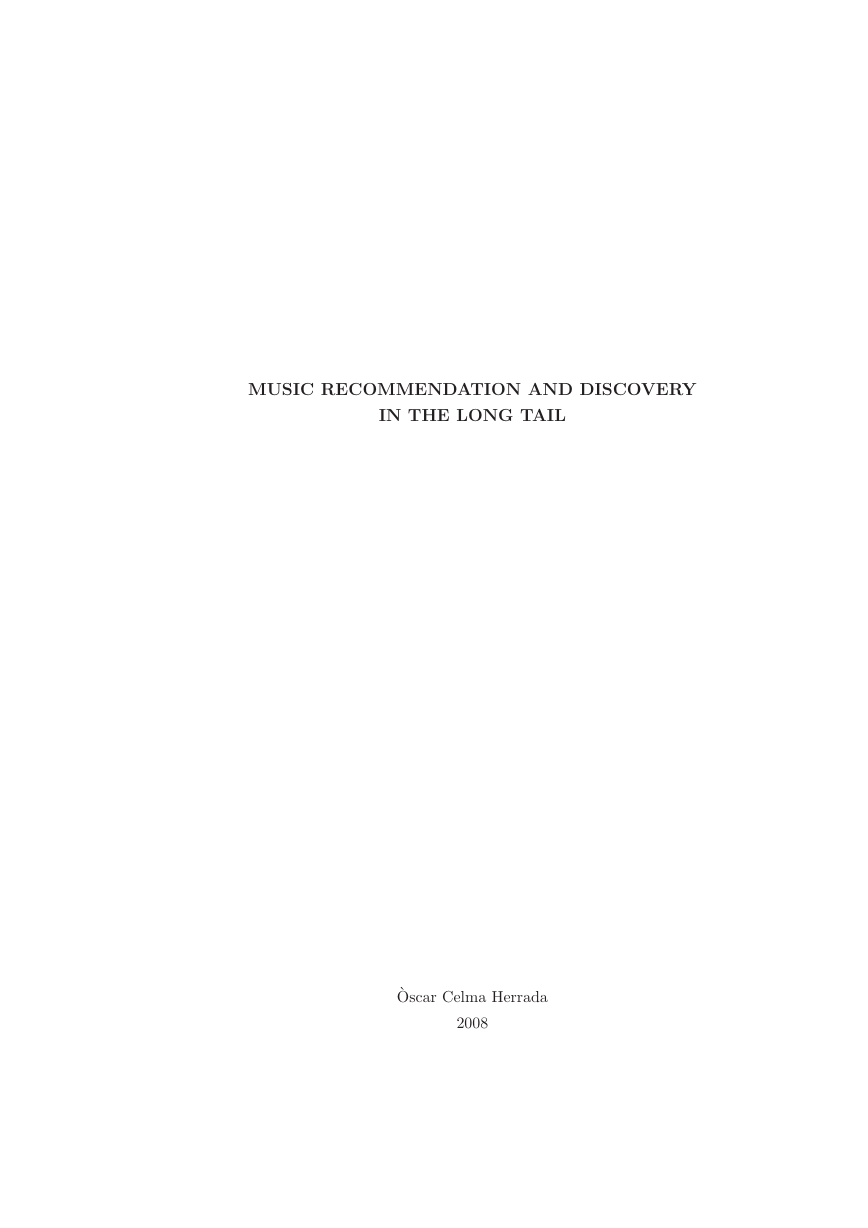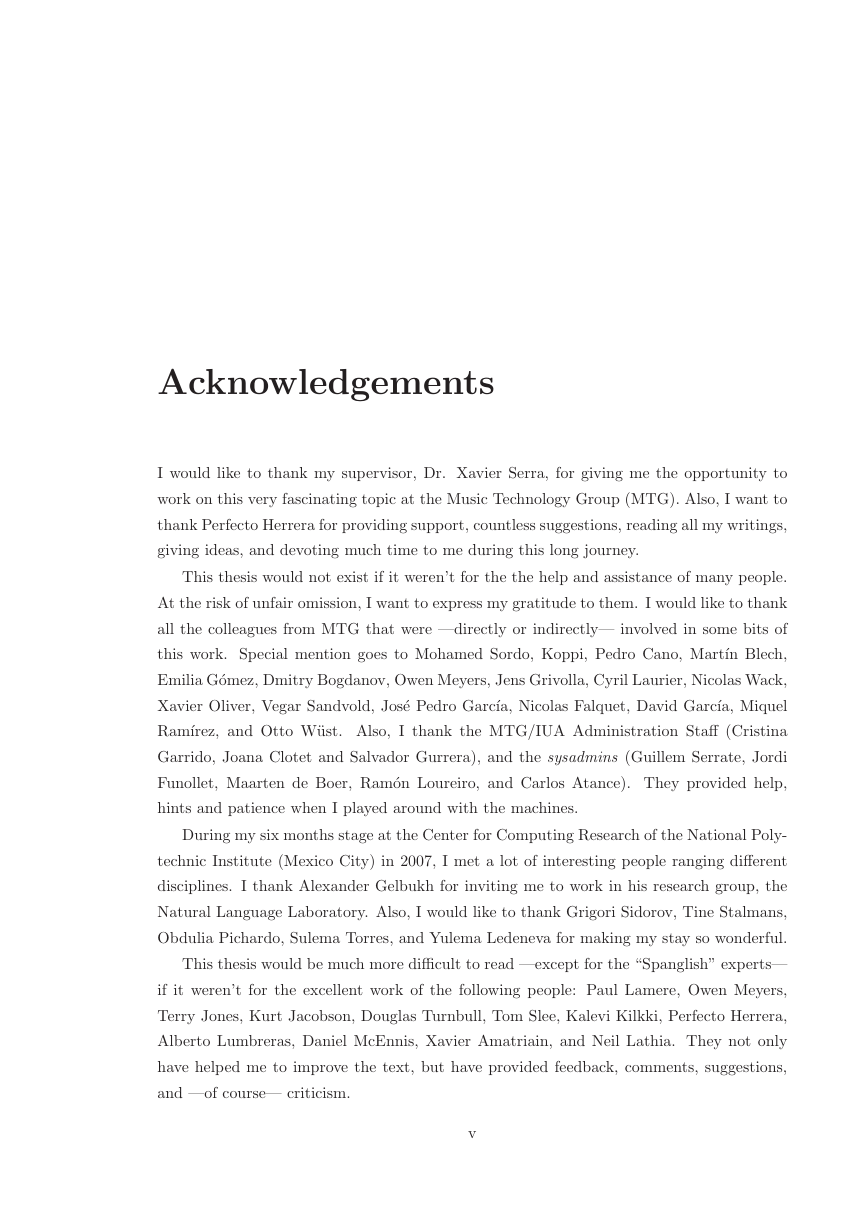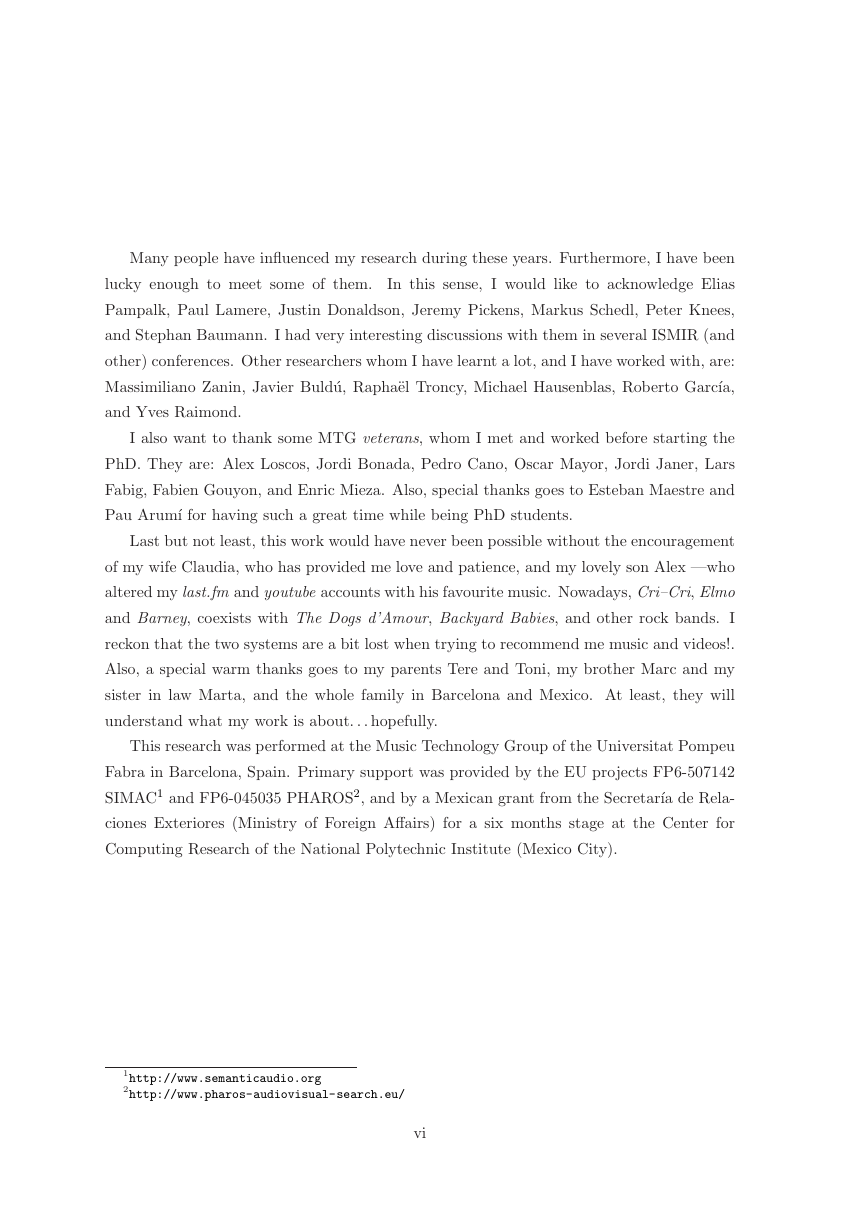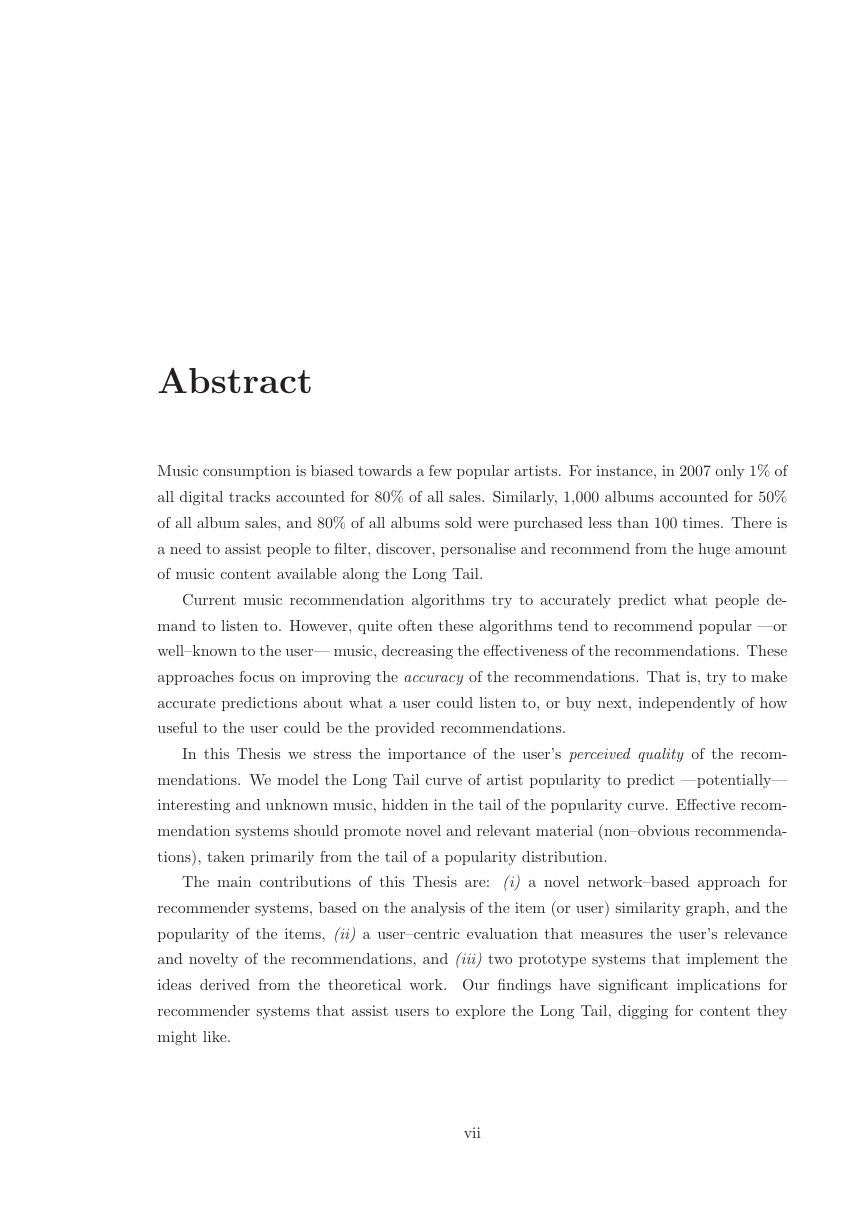MUSIC RECOMMENDATION AND DISCOVERY
IN THE LONG TAIL
`Oscar Celma Herrada
2008
�
c Copyright by `Oscar Celma Herrada 2008
All Rights Reserved
ii
�
who bring the whole endeavour into perspective.
To Alex and Claudia
iii
�
iv
�
Acknowledgements
I would like to thank my supervisor, Dr. Xavier Serra, for giving me the opportunity to
work on this very fascinating topic at the Music Technology Group (MTG). Also, I want to
thank Perfecto Herrera for providing support, countless suggestions, reading all my writings,
giving ideas, and devoting much time to me during this long journey.
This thesis would not exist if it weren’t for the the help and assistance of many people.
At the risk of unfair omission, I want to express my gratitude to them. I would like to thank
all the colleagues from MTG that were —directly or indirectly— involved in some bits of
this work. Special mention goes to Mohamed Sordo, Koppi, Pedro Cano, Mart´ın Blech,
Emilia G´omez, Dmitry Bogdanov, Owen Meyers, Jens Grivolla, Cyril Laurier, Nicolas Wack,
Xavier Oliver, Vegar Sandvold, Jos´e Pedro Garc´ıa, Nicolas Falquet, David Garc´ıa, Miquel
Ram´ırez, and Otto W¨ust. Also, I thank the MTG/IUA Administration Staff (Cristina
Garrido, Joana Clotet and Salvador Gurrera), and the sysadmins (Guillem Serrate, Jordi
Funollet, Maarten de Boer, Ram´on Loureiro, and Carlos Atance). They provided help,
hints and patience when I played around with the machines.
During my six months stage at the Center for Computing Research of the National Poly-
technic Institute (Mexico City) in 2007, I met a lot of interesting people ranging different
disciplines. I thank Alexander Gelbukh for inviting me to work in his research group, the
Natural Language Laboratory. Also, I would like to thank Grigori Sidorov, Tine Stalmans,
Obdulia Pichardo, Sulema Torres, and Yulema Ledeneva for making my stay so wonderful.
This thesis would be much more difficult to read —except for the “Spanglish” experts—
if it weren’t for the excellent work of the following people: Paul Lamere, Owen Meyers,
Terry Jones, Kurt Jacobson, Douglas Turnbull, Tom Slee, Kalevi Kilkki, Perfecto Herrera,
Alberto Lumbreras, Daniel McEnnis, Xavier Amatriain, and Neil Lathia. They not only
have helped me to improve the text, but have provided feedback, comments, suggestions,
and —of course— criticism.
v
�
Many people have influenced my research during these years. Furthermore, I have been
lucky enough to meet some of them.
In this sense, I would like to acknowledge Elias
Pampalk, Paul Lamere, Justin Donaldson, Jeremy Pickens, Markus Schedl, Peter Knees,
and Stephan Baumann. I had very interesting discussions with them in several ISMIR (and
other) conferences. Other researchers whom I have learnt a lot, and I have worked with, are:
Massimiliano Zanin, Javier Buld´u, Rapha¨el Troncy, Michael Hausenblas, Roberto Garc´ıa,
and Yves Raimond.
I also want to thank some MTG veterans, whom I met and worked before starting the
PhD. They are: Alex Loscos, Jordi Bonada, Pedro Cano, Oscar Mayor, Jordi Janer, Lars
Fabig, Fabien Gouyon, and Enric Mieza. Also, special thanks goes to Esteban Maestre and
Pau Arum´ı for having such a great time while being PhD students.
Last but not least, this work would have never been possible without the encouragement
of my wife Claudia, who has provided me love and patience, and my lovely son Alex —who
altered my last.fm and youtube accounts with his favourite music. Nowadays, Cri–Cri, Elmo
and Barney, coexists with The Dogs d’Amour, Backyard Babies, and other rock bands. I
reckon that the two systems are a bit lost when trying to recommend me music and videos!.
Also, a special warm thanks goes to my parents Tere and Toni, my brother Marc and my
sister in law Marta, and the whole family in Barcelona and Mexico. At least, they will
understand what my work is about. . . hopefully.
This research was performed at the Music Technology Group of the Universitat Pompeu
Fabra in Barcelona, Spain. Primary support was provided by the EU projects FP6-507142
SIMAC1 and FP6-045035 PHAROS2, and by a Mexican grant from the Secretar´ıa de Rela-
ciones Exteriores (Ministry of Foreign Affairs) for a six months stage at the Center for
Computing Research of the National Polytechnic Institute (Mexico City).
1http://www.semanticaudio.org
2http://www.pharos-audiovisual-search.eu/
vi
�
Abstract
Music consumption is biased towards a few popular artists. For instance, in 2007 only 1% of
all digital tracks accounted for 80% of all sales. Similarly, 1,000 albums accounted for 50%
of all album sales, and 80% of all albums sold were purchased less than 100 times. There is
a need to assist people to filter, discover, personalise and recommend from the huge amount
of music content available along the Long Tail.
Current music recommendation algorithms try to accurately predict what people de-
mand to listen to. However, quite often these algorithms tend to recommend popular —or
well–known to the user— music, decreasing the effectiveness of the recommendations. These
approaches focus on improving the accuracy of the recommendations. That is, try to make
accurate predictions about what a user could listen to, or buy next, independently of how
useful to the user could be the provided recommendations.
In this Thesis we stress the importance of the user’s perceived quality of the recom-
mendations. We model the Long Tail curve of artist popularity to predict —potentially—
interesting and unknown music, hidden in the tail of the popularity curve. Effective recom-
mendation systems should promote novel and relevant material (non–obvious recommenda-
tions), taken primarily from the tail of a popularity distribution.
The main contributions of this Thesis are: (i) a novel network–based approach for
recommender systems, based on the analysis of the item (or user) similarity graph, and the
popularity of the items, (ii) a user–centric evaluation that measures the user’s relevance
and novelty of the recommendations, and (iii) two prototype systems that implement the
ideas derived from the theoretical work. Our findings have significant implications for
recommender systems that assist users to explore the Long Tail, digging for content they
might like.
vii
�
viii
�
















 2023年江西萍乡中考道德与法治真题及答案.doc
2023年江西萍乡中考道德与法治真题及答案.doc 2012年重庆南川中考生物真题及答案.doc
2012年重庆南川中考生物真题及答案.doc 2013年江西师范大学地理学综合及文艺理论基础考研真题.doc
2013年江西师范大学地理学综合及文艺理论基础考研真题.doc 2020年四川甘孜小升初语文真题及答案I卷.doc
2020年四川甘孜小升初语文真题及答案I卷.doc 2020年注册岩土工程师专业基础考试真题及答案.doc
2020年注册岩土工程师专业基础考试真题及答案.doc 2023-2024学年福建省厦门市九年级上学期数学月考试题及答案.doc
2023-2024学年福建省厦门市九年级上学期数学月考试题及答案.doc 2021-2022学年辽宁省沈阳市大东区九年级上学期语文期末试题及答案.doc
2021-2022学年辽宁省沈阳市大东区九年级上学期语文期末试题及答案.doc 2022-2023学年北京东城区初三第一学期物理期末试卷及答案.doc
2022-2023学年北京东城区初三第一学期物理期末试卷及答案.doc 2018上半年江西教师资格初中地理学科知识与教学能力真题及答案.doc
2018上半年江西教师资格初中地理学科知识与教学能力真题及答案.doc 2012年河北国家公务员申论考试真题及答案-省级.doc
2012年河北国家公务员申论考试真题及答案-省级.doc 2020-2021学年江苏省扬州市江都区邵樊片九年级上学期数学第一次质量检测试题及答案.doc
2020-2021学年江苏省扬州市江都区邵樊片九年级上学期数学第一次质量检测试题及答案.doc 2022下半年黑龙江教师资格证中学综合素质真题及答案.doc
2022下半年黑龙江教师资格证中学综合素质真题及答案.doc